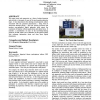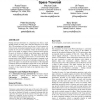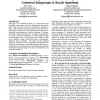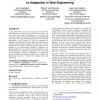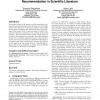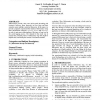HT
2007
ACM
14 years 4 months ago
2007
ACM
This paper treats web generators as a form of online hypertext and provides a taxonomy of some of the most popular generator types. It also characterizes the ideology of part...
HT
2007
ACM
14 years 4 months ago
2007
ACM
HT
2007
ACM
14 years 4 months ago
2007
ACM
In this paper we present a visual education tool for efficient and effective learning. The toolkit is based on a simple premise: simple concepts should be learned before advanced ...
HT
2007
ACM
14 years 4 months ago
2007
ACM
Finding relevant information in a hyperspace has been a much studied problem for many years. With the emergence of so called Web 2.0 technologies we have seen the use of social sy...
HT
2007
ACM
14 years 4 months ago
2007
ACM
Web sites must often service a wide variety of clients. Thus, it is inevitable that a web site will allow some visitors to find their information quickly while other visitors have...
HT
2007
ACM
14 years 4 months ago
2007
ACM
Web pages can be modeled as nodes in a social network, and hyperlinks between pages form links (relationships) between the nodes. Links may take the form of comments, for example ...
HT
2007
ACM
14 years 4 months ago
2007
ACM
In the modern Web, users are accessing their favourite Web applications from any place, at any time and with any device. In this setting, they expect the application to user-tailo...
HT
2007
ACM
14 years 4 months ago
2007
ACM
We present a study of the degree to which annotations overlap when several researchers read the same set of scientific articles. Our objective is to determine whether there is suf...
HT
2007
ACM
14 years 4 months ago
2007
ACM
We present a method for effective navigation in structure of large information spaces. The method employs incremental browsing of the information space structure and visualizes in...
HT
2007
ACM
14 years 4 months ago
2007
ACM
Folksonomies provide a free source of keywords describing web resources; however, these keywords are free form and their semantics spans multiple contextual dimension. In this pap...
